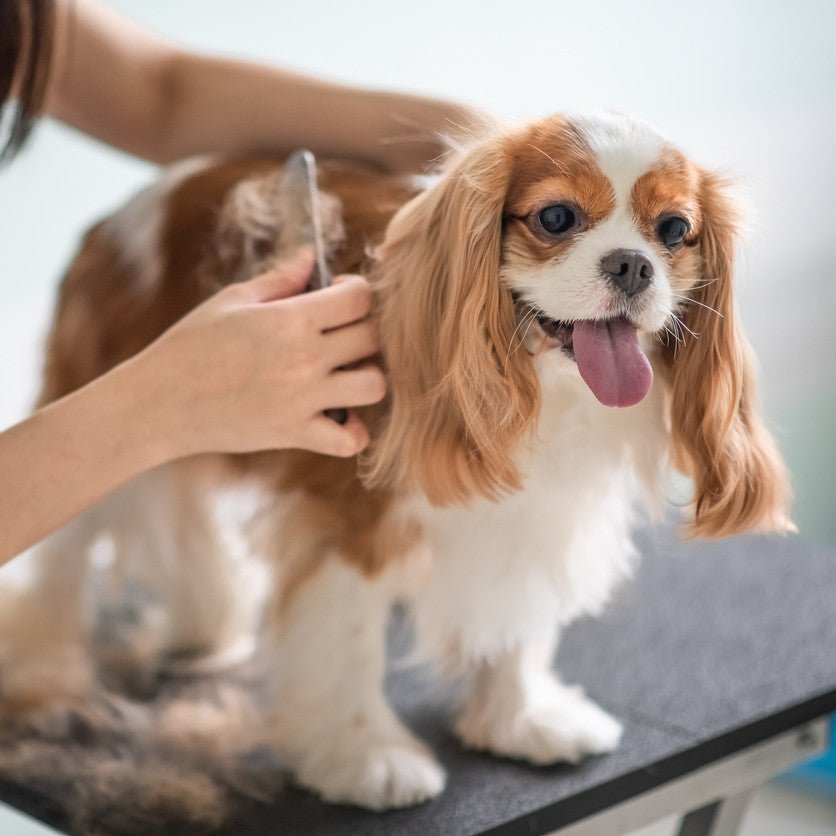How to Free Your Dog from Mats

Anyone who has a long-haired dog or one with thick or curly hair knows how it feels; you're running your fingers through your pet's coat, and they catch on a tight knot. Sometimes it seems like mats appear out of nowhere. These dense knots can cause problems for your pup, and they will only worsen if you don't take care of them.
But that doesn't mean you must rush to the dog groomer to de-mat your dog. With a bit of patience, some grooming tips, and the right tools, you can get rid of the mats yourself, ensuring your companion has a comfortable and healthy coat.
What causes mats?
Any dog with long enough fur can develop mats, but certain breeds are more prone to them, such as Poodles, Goldendoodles, Cocker Spaniels, Shih Tzu, Maltese, and Bichon Frise. These stubborn clumps of hair can be caused by a number of factors.
Shedding
When your dog is losing hair because of seasonal changes, the loose strands easily get tangled and knotted with the rest of their coat.
Friction
Areas that rub, such as the armpits or where the collar or harness rides, easily develop mats. Any regular back-and-forth motion against the hair can encourage mats to form.
Scratching
When a dog scratches because of allergies, fleas, or dry skin, the motion of their claws or teeth can create tangles that grow into mats. Even repeated licking can create knots.
Water
If your dog likes to swim, romp on wet grass, or play in the snow, that wet dog smell isn't your only concern. Wet dog hair mats much more quickly.
Why are mats a problem?
Of course, mats aren't attractive, but these stubborn knots aren't just a cosmetic problem. The tight tangle of fibers tugs on the skin, causing pain. Moisture and parasites can get trapped under mats, causing even more problems for the skin.
If mats have been a problem for your dog for a while, removing them will probably be uncomfortable. This often leaves dogs with sore, itchy skin. Since scratching is one of the things that can cause more mats, this can be a frustrating cycle to break.
If the mats grow large enough, they can even pull the skin so tight that it restricts blood flow, creating bruising and wounds. If a dog develops large mats that are close to the skin, it's known as pelted. In this situation, it's best to have a dog groomer or vet take care of the mats. Your dog will probably need to be shaved to get rid of the problem.
How can you prevent mats?
The best way to prevent mats is to keep your dog's coat clean and groomed. Either take them to a dog groomer regularly or keep on top of their trims yourself. If they need a bath, be sure to use gentle, moisturizing products, to reduce irritation and itching. Be careful to thoroughly dry their coat when you're done. (Note: don't give your dog a bath if they already have mats, because water will make them worse.)
To make sure you keep up with untangling knots before they become mats, you may have to brush your dog every day. Remove their collar or harness to make sure you can reach all the areas you need to. To make sure you aren't just brushing the top layer of their coat, many groomers recommend that you use a metal comb and a slicker brush or pin brush. The metal comb will help you find the tangles, and the brush will help you work through them.
For dogs that shed a lot, a de-shedding brush will help you clear out loose hair. Whatever type of brush you use on your dog, a conditioning detangling spray can make the job much easier and help to keep their coat sleek.
How do you remove mats?
Despite your best efforts, your dog will probably still manage to develop a few mats. It happens. If you discover large, tight mats, it's best to let a professional groomer or vet shave them. But for just a few small mats, you can probably take care of them at home before they get any worse.
First of all: don't try to cut them out with scissors! It's way too easy to accidentally cut your dog's skin, which can cause so much bleeding that they need stitches. It's much safer to shave them out using clippers.
Instead, use an oil-based detangling spray to soften the knots. Then hold onto the fur between the mat and the skin, to minimize pulling. Try to gently pull the mat apart into smaller tangles. Then, using a metal comb, comb it out with short, fast strokes. Once you can smoothly run the comb through the fur, follow up with a slicker brush to brush out their coat, so it's sleek and tangle-free.
A dematting rake can be helpful, but be sure to use it carefully. Don't try to slice through the mat on a single stroke, but use it gently on the edges to untangle it and break it up into smaller pieces.
As you work to remove a mat, your dog will probably become uncomfortable and try to pull away. Take frequent breaks and give them treats to help them relax. Take your time, and you'll soon have a happy pup with a smooth coat.
Frequently Asked Questions
How do you get rid of matted hair on a dog?
If the mat isn't very big or too close to the skin, you can try to gently detangle it yourself. Use an oil-based detangling spray and carefully work through the mat with a steel comb.
Is matted hair painful for dogs?
It can be, especially large, tight, stubborn mats that cause pressure on the skin. Moisture, germs, and parasites can hide behind mats, leading to skin problems and pain.
What loosens matted dog hair?
With a good detangling spray, the right tools, and some patience, you may be able to work through a small section of matted fur and comb it out.
Mats can be miserable, but you can help get them out of your dog's coat. At Animals Matter, we understand how important your pup is to you, so we do our best to offer the information and products you need to give them their best life. For more information, contact us today.
Subscribe
Sign up to get the latest on sales, new releases and more…
Categories
- Tails of Celebration: Working Dogs of the Lares Trek, A Silent Partnership In Peru
- 5 Easy Organic Christmas Recipes for Dogs: Simple Holiday Treats Your Companion Will Love
- The 6 Best Luxury Gifts for Your Dog This Christmas: Thoughtful Holiday Comfort That Truly Lasts
- Why Playtime Matters: The Benefits of Mental Stimulation and Playtime with Your Companion
- Tails of Celebration: The Miao Dog-Carrying Festival - A Hero's Honor in China
- A Dog-Friendly Thanksgiving 2025: Comfort, Calm, and Easy Treat Recipes
- The Best Dog Beds for Winter 2025: 5 Luxury Styles for Warmth, Comfort & Orthopedic Support
- Tails of Celebration: The Feast of Saint Hubert — Belgium's Timeless Blessing
- Halloween Safety Tips for Dogs: How to Keep Your Companion Safe This Spooky season
- Tails of Celebration: Día de los Muertos / Day of the Dead for Pets, A Festival of Memory in Mexico
- How to Care for Senior Dogs in Fall: Mobility Tips & Joint Support
- Tails of Celebration: Kukur Tihar & The Tihar Festival of Nepal
- What is a VDI Testing for dogs ? : Insights, Procedures and Preventive Measures
- Cheap Dog Beds vs. Luxury Dog Beds: The Real Cost of a $50 "Disposable" Dog Bed
- Can Dogs Have OCD? Understanding Canine Compulsive Behaviors (CCD)
- Does My Dog Like Music? Find Out What Tunes Make Your Pup Wag!
- Effective Solutions for Food Aggression in Dogs
- 7 Frozen Treats Your Dog Will Love This Summer☀️🧊🍉
- The Best Waterproof Liners for Dog Beds: Protect Against Spills, Drool, and Accidents
- How to Cope with the Loss of a Dog: A Tribute to Every Companion We Carry in Our Hearts
- Top Tips on How to Prevent Matting in Dogs
- Understanding and Managing Dogs with Hip Dysplasia
- The Ultimate Guide to Dog Gut Health: Natural Remedies, Probiotic Insights and Signs of Poor Gut Health
- The Best Supplements for Dogs: Explore Top Picks for Canine Health and Wellness
- How Often Should I Brush My Dog's Teeth? Tips for Optimal Canine Dental Health
- Ultimate Guide on How to Comfort Your Dog During Fireworks this 4th of July
- Managing a Blowing Coat: Essential Grooming Tips for Double-Coated Dogs.
- 5 Daily Habits That Boost Your Dog’s Long-Term Wellness
- Mastering Crate Training a Dog: Tips and Benefits
- Dog Car Seats vs. Seat Covers: What’s The Best Option For Your Companion?
- Best Outdoor Dog Beds: Luxury, Durability, and Unmatched Comfort
- Is My Dog Overweight? Tips to Assess and Help Your Companion
- The Best Faux Fur Dog Beds for Ultimate Pet Comfort of 2025
- Dog Running Guide: How to Start, Train & Stay Safe when running with your Dog
- Indestructible Dog Beds? The Truth Behind the Term
- Top Tips for Effective Exercise for Dogs
- Effective Dog Ear Cleaning: A Step-by-Step Guide for Maintaining Healthy Ears
- How to Manage Dog Aggressive Behaviors: Expert Tips and Advice
- Effective Canine Ear Infection Remedies: Symptoms, Causes & Treatments
- How to Make a New Dog Comfortable in Their New Home - 2025 Guide
- Signs of Dog Allergy Symptoms and How to Help and Prevent Them
- Why Does My Dog Lick Their Paws? Causes and Solutions Explained
- Dog Alzheimer's: Symptoms, Causes, and Treatment Options
- The Legacy of Comfort with the Iconic Animals Matter® Ortho Companion-Pedic® Puff Luxury Dog Bed
- Orthopedic Square Dog Beds: The Ultimate Blend of Luxury, Comfort, and Support
- Loungers: The Ultimate Beds for Luxury, Comfort, and Orthopedic Support
- Square Dog Beds: Orthopedic Comfort and Stylish Designs for Your Companion
- Effective Solutions for Canine Incontinence: Identifying Causes and Best Treatments
- Ethical, Sustainable, and Certified: Why Certified Products Matter, Exploring CA Prop 65 and CertiPUR-US® Standards
- Dog Seizures: Signs, Causes, and How to Help Dogs with Seizures


Leave a comment
Please note, comments must be approved before they are published